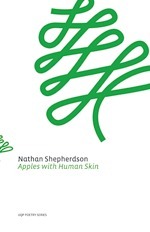
- Free Article: No
- Contents Category: Poetry
- Review Article: Yes
- Article Title: Shards of meaning
- Online Only: No
- Custom Highlight Text:
Apples with Human Skin is a collection of taut but detached poems. Well crafted, with superb use of diction coupled with tight and inventive forms, the poems remain, however, unrelated to anything in modern-day usage or consciousness. There is a coolness to the writing which can become relentless. Imagery and line structure are evocative and precise, and Shepherdson successfully invents a minimalist syntax in each of the longer chaptered poems. There are also shards of social comment hidden amongst the granite-like structures.
- Book 1 Title: Apples With Human Skin
- Book 1 Biblio: University of Queensland Press, $24.95 pb, 153 pp
- Book 1 Cover Small (400 x 600):

- Book 1 Cover (800 x 1200):

Shepherdson is a master of imagery. His ability to create and combine the obscure and bizarre is a feature of the poetry. Often such writing impedes the poems’ flow. In ‘trakl’, ‘the remains of your eyes / scraped into sockets of blame’. Here, the succinctness of the imagery works in tandem with the small forms employed in each of the twenty-seven poems that form the whole. In more dense poems, such as ‘i had a dream i was talking to Lawrie Daws on the phone’, the layers of imagery leave little room for cognition or absorption:
the head you are thinking with is stolenit remains the property of the next decision you will make
minute sketches kept frozen in saliva
anodized trays overflowing with un-numbered souls
visual aphorisms mobilized against synthetic space
plastic cups to catch the prophet’s tears
In ‘to find what is not there’, however, the two-line stanzas are perfectly suited to the word play: ‘it is the last day of the year / and thousands of ears will wash up onto the beach’, Shepherdson’s fascination with anatomy and nature creating an oblique and disturbing synergy. The subject matter of the poems includes explorations of the life and thoughts of Austrian poet Georg Trakl and visual artists Lawrie Daws and Lucas Cranach, a piece written in collaboration with film-makers and some ekphrastic poems inspired by paintings. For the most part, any link between source and poetic response remains obscure. There are times, however, when Shepherdson writes in a manner which suggests a wider perspective. In ‘Eve 1528’, we are privy to a remark hinting at a wider social malaise: ‘it is a rare moment / where we are allowed to unbutton the filaments in our eyes / indulge in a profound emptiness.’ And in ‘to find what is not there’, Shepherd-son works a deeper philosophy regarding society’s obsessions with over-achievement and consumerism:
this is a hospital for unsatisfied dreams
where personality is fitted with prosthetics for the new centurythis is a quaint comedy where your ego is towed out to sea
and scuttled unceremoniously for use as an artificial reefit is well known that fingers will float in a bowl of tears
that the lighthouse in the conscience actually attracts pain
The poetry is at its most lucid here, providing elegant but surprising turns of phrase to form a linear muscularity.
Efficiency of word choice, grammar and form are hallmarks of these poems; together they create a unique syntax. The majority of the poems are written in the second or third person, and the concepts of absence and voyeurism are important ideals in Shepherdson’s poetic purpose. In ‘zwanzig’ we read, ‘a warm hum / seeps along the suture lines / his body poured into its dispensary coat / the starched armor of his profession’, typical in its density of line and voice. Further on in the volume, in ‘unnecessary messages for those in need of unnecessary messages’:
.in the stillness of the stillness at the stillness the stillness barks.
.from the stillness to the stillness with the stillness the stillness jumps.
.bend a single preposition into the surface of everything.
.nothing can save us because nothing has saved us.
.all objects are hands.
.all objects are hands.
There is minimalist intent here, a tumble of syllables, internal rhyme, meaning and meta-poetry. Shepherdson is to be admired for having woven such a wordscape.
The difficulty with the poems lies in their evasive intent, absence of natural breath and cadence, and overly mannered grammatical style. The question ‘so what?’ regularly comes to mind. There is little emotional engagement or familiar territory; seemingly no way to infiltrate the poems’ structure or heart. In ‘Eve 1528’, this is a resting image
it can neither fall nor ascend
it has on this page
a found object lost in belief
(away from & close to) (away from & close to)
This kind of philosophy for philosophy’s sake is all too abundant throughout the work.
Apples with Human Skin is the work of an experienced and skilled poet, and the images are both compelling and beautifully honed. However, Shepherdson seems to have forgotten about the reader and about the importance of their role and needs within the artistic and textual contract.


Comments powered by CComment